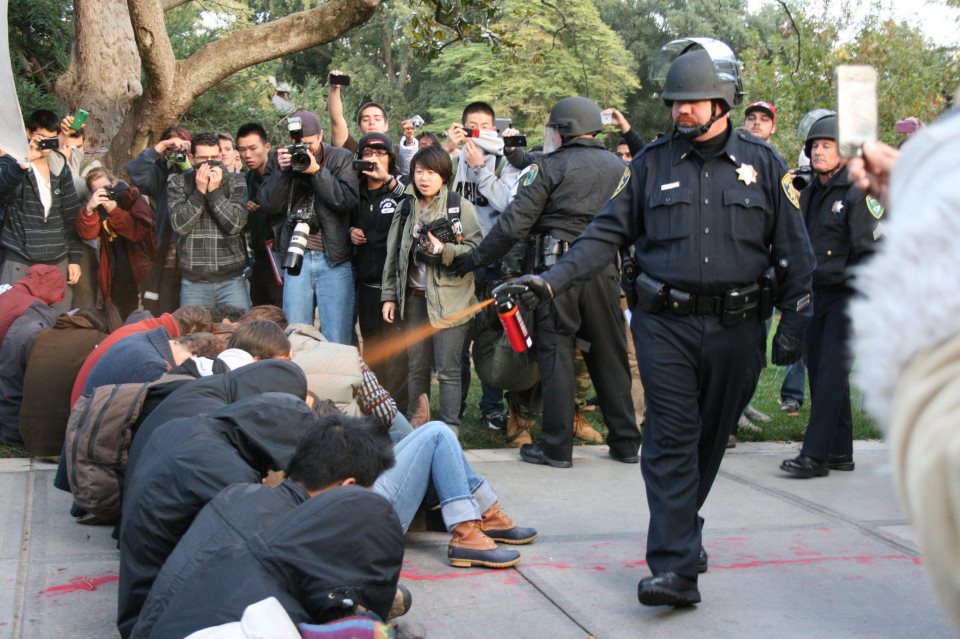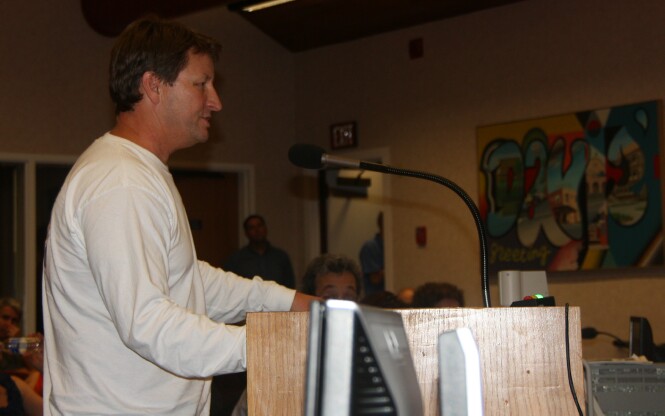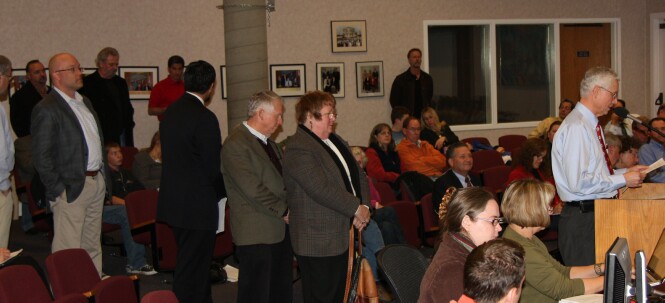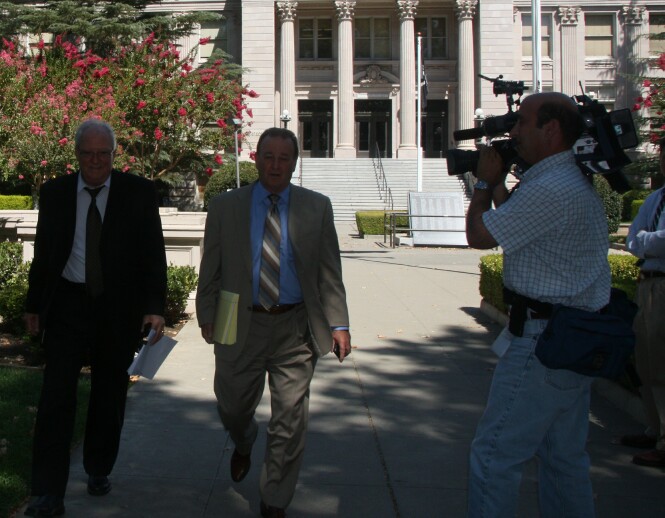
2011 was a momentous year locally and while deciding the top story was easy, in other years any of the top three would have been the top story and as many as the top six or seven could have been.
We knew going into 2011 that it was going to be an interesting year. The year began with a council vacancy to be filled, a city manager to hire, a budget to pass, and a water project looming.
What we did not know is that a group of students in tents would steal the headlines not only in Davis, but capture the attention of the nation and the world.
It was a great year for the Vanguard. Readership in the fifth full year of the Vanguard was up an astounding 60%. We packed the Woodland Community and Senior Center with nearly 300 people to hear experts talk about wrongful convictions.
But as always, 2011 was about the news and the Vanguard was the place to discuss that news. Here are the top 5 stories for the year.
 No. 5 – Measure A – School District’s $200 Parcel Tax Increase
No. 5 – Measure A – School District’s $200 Parcel Tax Increase
Generally, parcel tax elections are like watching the grass grow – just add water and occasionally trim around the edges to keep it neat. But in 2011, an aggressive school board put a $200 parcel tax increase on the ballot as a two-year emergency measure to buffer the district against more state funding cuts, and this time, a number of missteps and miscalculations turned the measure into a very narrow and contentious victory.
The biggest point of contention was a letter mailed by Superintendent Winfred Roberson to seniors, at district expense, that critics claimed moved from information to advocacy.
That story was fanned by Davis Enterprise Columnist Bob Dunning, who accused Superintendent Winfred Roberson of “Politicking on the public’s dime.” Wrote the columnist, “Our superintendent of schools has decided to take matters into his own hands by sending out a letter on official district letterhead to this town’s senior citizens, urging a ‘Yes’ vote on this critical school funding measure.”
He continued, “Now, if you’re raising an eyebrow about the appropriateness of a public official spending public money to influence the outcome of an election, you are not alone. Unfortunately, there’s more.”
The letter was the subject of an Fair Political Practices Commission complaint that ended with no actions taken by the agency. There were other controversies along the way, such as the use of an all-mail ballot which proved cost-effective and produced no known complaints.
The measure would ultimately receive 67.1 percent of the vote, narrowly passing.
Key stories: The District Clarifies the Purpose of the Letter, FPPC Complaint Filed Against the District on Measure A, Measure A Passes By the Skin of Its Teeth
No. 4 Marco Topete Death Penalty Case
It was a case that never wanted to end and a trial that prosecutors could never quite get right. It began on June 15, 2008 with a traffic stop near the I-80 rest stop in Dunnigan. Marco Topete would lead Yolo County Sheriff’s Deputy Tony Diaz on a high-speed chase before stopping on his friend’s dark rural property and opening fire.
From there it was a matter of trials and tribulations, as sheriff’s deputies locked out the public and media at his June 18 arraignment, Yolo County would fight to keep the case in county, Mr. Topete would first fire and then take back his appointed attorneys in late 2010, and on the eve of trial co-council Tom Purtell suffered a serious stroke and the trial was pushed back to August.
“Norteño Gangs,” were the first words uttered by Deputy District Attorney Garrett Hamilton, demonstrating the continued District Attorney’s office focus on gangs and gang activities. But on that opening day, it was the emotional reaction to a vivid and horrifying 15-minute video of the chase and ultimate shooting of the deputy that nearly brought the case to a halt once again, as dozens of family members began weeping openly in court in full view of the jury and one woman could be heard wailing down the hall so loudly that virtually the entire courthouse heard it.
The scene prompted defense attorneys Hayes Gable and Dwight Samuel to seek a mistrial. “This was the worst outcry I have ever seen,” Mr. Samuel told Judge Richardson.
As Mr. Hamilton described it, Mr. Topete lay in wait, setting the officer up for an ambush that would end his life. “He lured him like a predator lures his prey to an area where he had a total advantage,” Mr. Hamilton told the jury. He was “lying in wait having totally set him up, in so doing he was doing the ultimate as a Norteño,” he added.
The defense was left to argue that Mr. Topete was drunk and angry. That he came from a very troubled background and never stood a chance. But it was the defense that never stood a chance in either the guilt or penalty phase.
In arguing for the death penalty, DA Jeff Reisig argued, “Make no mistake about it, Marco Topete has been the sole author of his demise.”
“No matter where Marco Topete goes, people are at risk,” said Mr. Reisig. “No one in the free world is immune from his wrath.”
No one in the correctional system is safe, he continued, saying that there is a pattern of violence behind bars from this respected gang leader. “I urge you not to play Russian Roulette with the lives of correctional officers,” Mr. Reisig added.
He later argued that there is a “viciousness,” an “evil that lurks in his heart,” as he referenced a 2003 letter to Mr. Topete’s father that describes the fact that he does not forgive, he is a cruel person, and he hopes no one in the family sees the damage that he could do.
In his defense, Attorney Dwight Samuel pointed out that as a youngster he had an outlaw father who was toxic, who used to beat young Marco. His father was an alcoholic, engaging in drug sales and pulling Marco in at a young age, and he was put in prison when Marco was 15. When he returned, he started selling drugs and involving Marco.
“We’ve got an outlaw father, and now we’ve got an outlaw son,” Mr. Samuel said. “Is it Marco Topete’s choice? No, it is not.”
He would argue that Mr. Topete, as the result of these experiences, was “damaged goods” who never received the help or resources he needed to overcome his background.
Mr. Samuel argued that Mr. Topete had multiple risk factors. He argued that Mr. Topete never really had a choice about these factors – 16 of the 24 factors, he argued, were not his choice. Moreover, he had no help – only 3 of 15 protections were present and there was never a strong parental influence in his life.
There would be one twist in this trial – a juror during the penalty phase wrote a letter begging to be taken off the jury. It was ostensibly because of a language barrier, but later another juror suggested it was because of her opposition to the death penalty. Once that juror was dismissed, the jury reached the verdict of the death penalty in two days.
Key articles: Opening Act: Video of Police Shooting Draws Emotional Response from Family of Slain Deputy, Topete Trial Goes to the Jury in the Guilt Phase, DA Reisig Makes Emotional Case For Death Penalty in Topete Case Closing Arguments, Legal Experts Believe Judge Erred in Dismissing Juror in Death Penalty Case, Analysis: Systemic Failure Greatly Contributed to Topete’s Killing of Deputy
 No. 3 The City Budget Battle
No. 3 The City Budget Battle
In other years, this might have been the top story of the year, but not in 2011. The issue of the budget has dominated Davis’ landscape since the recession began in 2008.
We have dealt with the issues here in great detail, but the short version is that in the last decade the city made a series of questionable decisions on the budget. First, they enhanced retirement pensions while lowering retirement age. Then they drastically increased salaries.
They were able to pay for this due to their half-cent sales tax that was renewed in 2010, and due to the double-digit increases in property tax revenue during the last decade. When that revenue stream shut down, the city was sitting on a time bomb.
The previous council and city manager had a chance to deal with the core structural issues during their last round of MOUs from 2009-2010. However, perhaps bowing to pressure from employee groups who helped elect them, the council majority, in a series of 3-2 votes, approved very modest contracts, and the city’s policy for dealing with the ongoing deficit was to allow employees to retire and transfer and not fill their positions.
Rochelle Swanson and Joe Krovoza were elected in part to fix the long-term structural problems of the city budget, and along with appointee Dan Wolk formed the 3-2 majority that put words into action.
Joe Krovoza, with Rochelle Swanson, in June moved to cut $2.5 million from personnel costs and put $1 million toward infrastructure and the rest toward shoring up unfunded retirement health liabilities and pensions.
At a hot and contentious late night meeting, attended by 150 city employees, a divided council would pass dramatic budget cuts.
As Mayor Pro Tem Rochelle Swanson said, “All during the 2010 campaign every single forum, every single debate, we talked about fiscal sustainability.” This has been repeatedly brought up, she said, they asked for community conversations. “This isn’t new. It is painful; it should have been before,” she continued. “It is incredibly unfortunate in the way it is happening,” she said, “but we can’t keep kicking this can down the road.”
The unlikely allies of Sue Greenwald and Stephen Souza opposed it.
Councilmember Souza argued “We shouldn’t fool ourselves into thinking that we are going to achieve $2.5 million without people losing their jobs.” Unless there are concessions, negotiated people will lose their jobs. He argued you “don’t say you are going to talk to you at the same time you are targeting them.”
He said he wanted true constructive dialogue and believes the prior path was the right path. “This one is not the right path.”
Sue Greenwald would argue that the good thing right now is that we have a council determined to make these changes. She said the question is how to do it in a way that minimizes layoffs. She argued that we have a very heavy-handed layoff approach and that we cannot even choose whom we lay off, by law.
Dan Wolk would end up casting the deciding vote, arguing that this is “an era of shared sacrifice,” and it is “incumbent upon us as a community to come together to devise a way to ensure the long-term fiscal stability of our city.”
As it turned out, the water issue and the timing of hiring a new city manager precluded the council from acting by the specified September 30 date, but the council is pushing forward with their cuts at a more deliberate pace.
The city was dealt a further blow when its imposed contract on the largest bargaining group was nullified by an Administrative Law Judge presiding over a Public Employment Relations Board hearing. The improper impasse by the city may cost the city an additional $700,000 in back pay to employees.
Key articles: Council Passes Historic Budget 3-2 to Set Aside 2.5 Million in Personnel Costs to Put Towards Roads and Unfunded Liabilities, PASEA President Matt Muller’s Over-the-Top Response to the Vanguard
No. 2 – Surface Water Project

In terms of a purely Davis issue, this is the top issue, and only because of much broader national coverage is the top issue above it. The surface water project has been years in the making and, as late as the middle portion of this year, we openly wondered why the issue was not generating more interest.
That all would change during the Proposition 218 process – a fundamentally flawed protest system that allows rate payers to submit written protests for water rate hikes and if a majority of parcels protest, the rate hike is thrown out.
The originally proposed 28% rate hikes drew alarm bells from the business community, but behind the scenes they worked with the city to knock down the ultimate rates to 14%, or so we were led to believe.
On September 6, Dan Wolk and Rochelle Swanson were unable to get a third vote on a compromise that would have put in place a one-year ten percent rate hike, while the council and city studied the issue and worked to minimize impacts. As a result, they reluctantly joined on a 4-1 vote to implement the 14% rate hikes.
Within days, a small group of residents would come together to put a referendum on the ballot to rescind the rate hikes. Relying on paid canvassers to get a larger number of signatures in a 30-day window, they would narrowly qualify a referendum for the ballot.
In the meantime, we would learn that the 14% rate hikes were only 14% if one met the 20% conservation assumption, but otherwise they were actually, in terms of per unit rate increase, nearly double that. And that is if one remained within the first tier.
Moreover, it appears even one of the councilmembers was confused, as Dan Wolk told Bob Dunning: “The motion I voted for calls for maximum rate increases of 14 percent per year. Your math (which looks right to me) shows that is not necessarily the case for some.”
Mayor Pro Tem Rochelle Swanson would later call the rate structure implemented on September 6, “clearly untenable” and argued that she would not “support a rate going [up] that doesn’t have a rate study behind it.”
Unlike many, and to her credit, she admitted her mistake, “That was a mistake, I regret not sticking to my guns in September and only doing the one year.”
The interim public works director would also have to admit his mistake. Mr. Clarke wrote on November 3:
“The confusion and the misperception that the city has been less than forthcoming stems from the way in which the rate increase was characterized in staff reports. While staff attempted to point out in our reports and at our dozens of communitywide and interest group meetings all the factors impacting the rates, we didn’t do a very good job of differentiating clearly among the actual rate increase, the increase in customer water bills and the total increase in revenue.”
“The overall amount an individual household’s bill will change varies based on usage. As many people have correctly observed, the maximum rates shown in the Proposition 218 notice and adopted by the council represent more than a 14 percent increase for each year (14 percent was cited in a staff report as being the average annual rate increase for single-family residential users). “
It was Rochelle Swanson and Dan Wolk who ultimately brought back a modified version of their original compromise motion. This one rescinds the rate increases and asks the city staff to work toward doing an actual rate study.
In a further compromise, the council has asked staff to put an initiative on the ballot which would appear to be an up or down vote in June on the water supply project itself. In the meantime, as council was hitting the pause button, all five members of the Woodland City Council and Supervisor Matt Rexroad warned the council that Woodland might do it alone if the city backed out of its part of the Joint Powers Agreement.
The water issue figures to be one of the very top stories for 2012 – so stay tuned.
Key articles: Will Davis Voters Put a Water Rate Referendum on the Ballot?, Commentary: Councilmember Wolk Splitting the Baby on Water, This is Democracy? Council Raises Water Rates At Nearly 3:30 in the Morning, Water Referendum Qualified by Skin of Its Teeth, Swanson and Wolk Look To Pull Back on Water, Council Repeals Water Rate Hike; Will Put it To Vote in June, Commentary: Woodland’s Ill-Advised Pressure on Davis Backfires
No. 1 – UC Davis Explodes in Protester-Police Clash

In the 1960s when the protesters beaten by Chicago police were chanting the “whole world is watching,” they never envisioned what that would look like 43 years later in the age of instant media, cell phone video cameras, YouTube and Facebook.
Just when it seemed that the Occupy movement was about to die out, a confrontation that was brewing all week exploded as police officers used pepper spray and other non-lethal means to expel protesters from an encampment on the campus Quad at UC Davis on November 18, 2011.
Chancellor Katehi has issued a statement, “The group did not respond to requests from administration and campus police to comply with campus rules that exist to protect the health and safety of our campus community. The group was informed in writing this morning that the encampment violated regulations designed to protect the health and safety of students, staff and faculty. The group was further informed that if they did not dismantle the encampment, it would have to be removed.”
Her statement continued, “Following our requests, several of the group chose to dismantle their tents this afternoon and we are grateful for their actions. However a number of protestors refused our warning, offering us no option but to ask the police to assist in their removal.”
“We are saddened to report that during this activity, 10 protestors were arrested and pepper spray was used,” she said.
“We deeply regret that many of the protestors today chose not to work with our campus staff and police to remove the encampment as requested. We are even more saddened by the events that subsequently transpired to facilitate their removal,” the Chancellor added.
Calls for resignation were immediate and fierce.
Nathan Brown, an Assistant Professor in the English Department, sent an open letter to the Chancellor stating, “I am writing to tell you in no uncertain terms that there must be space for protest on our campus. There must be space for political dissent on our campus. There must be space for civil disobedience on our campus.”
He added, “You may not order police to forcefully disperse student protesters peacefully protesting police brutality. You may not do so. It is not an option available to you as the Chancellor of a UC campus. That is why I am calling for your immediate resignation.”
Chancellor Katehi on the following Monday would address a crowd that likely topped 5000 people, and attempted to apologize. “I’m here to apologize,” Chancellor Linda Katehi said, to a mostly polite response with a smattering of catcalls and resignation calls. “I feel horrible for what happened on Friday.”
“When you tell me you don’t want to be students at a university like we had on Friday,” she said, “I’m just telling you, I don’t want to be the chancellor of the university we had on Friday.”
“Our university needs to be better than it is and it needs all of the community to come together to do that,” she added. “I know you don’t believe everything that I say here today, and you don’t have to. It is my responsibility to earn your trust,” the Chancellor said.
Damage control was in order. Chancellor Katehi has so far resisted calls for resignation, offering several apologies, even putting the blame on police and the vice chancellor, while at the same time “taking responsibility.”
UC President Mark Yudof ordered multiple independent investigations, first getting former LA Police Chief William Bratton to head up a private security company’s investigation, and then getting former Supreme Court Justice Cruz Reynoso to lead the task force that will review the investigation results.
Key articles: Occupy UC Davis Explodes in Protester-Police Clash, Katehi Makes Brief Appearance to Large Audience on Quad, Commentary: Katehi’s Visit Does More Harm Than Good, Former Supreme Court Justice Cruz Reynoso Named to Chair Task Force on Pepper Spray Incident
—David M. Greenwald reporting


[quote]First they enhanced retirement pensions [u][b]while lowering retirement age[/b][/u]. [/quote]The highlighted part is either a lie or ignorance… the City adopted 2% @ 55 in the 80’s… the ‘normal’ retirement age (when one can first take benefits, at whatever rate) has been 50, since the 70’s. When the City went to the 2.5 @ 55 formula, the employees (non-public safety) agreed to pay the increased cost of the employer’s contribution for the following 5-6 years. In addition a council-member insisted on employees giving up an additional 1%, as a “premium”.
I really admire how David can ensure that fact should not get in the way of a ‘good story’.
Should be clear… all my comments pertain only to non-safety employees…